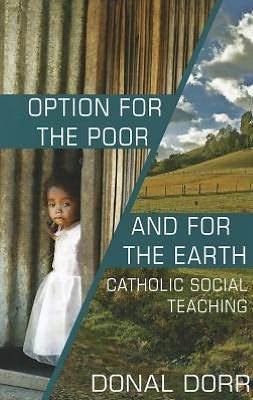Donal Dorr’s “Option for the Poor and for the Earth”
 Just finishing up reading Donal Dorr’s Option for the Poor and for the Earth: Catholic Social Teaching. This could well be considered the “gold standard” against which all other books on Catholic social teaching should be compared and judged.
Just finishing up reading Donal Dorr’s Option for the Poor and for the Earth: Catholic Social Teaching. This could well be considered the “gold standard” against which all other books on Catholic social teaching should be compared and judged.
Dorr first published his book Option for the Poor back in 1983. It was masterful summary of CST leading up to the centenary of Leo XIII’s Rerum Novarum. Dorr’s volume rightly met with wide acclaim and appeared in a second edition in 1992. For this third edition, published last year, Dorr revised and added so much that it was judged appropriate to revise the title, too.
Make no mistake — this is not a crass attempt by the publisher to put a new cover and title on an old book to sell it again. The new edition has over 200 pages of totally new material and much of the older material has been revised and updated. Of the brand new material, there are basically three parts: a whole new chapter on the church’s teaching on women, three chapters taking account of Pope Benedict XVI’s contribution to CST, and a new chapter on concern for the environment. Of these the chapters on women and the environment are good but somewhat cursory and not nearly as analytical as those on Benedict. The chapters on Benedict’s teaching and reactions to it are thorough, insightful, and fascinating.
These adjectives can also be used to describe the rest of the book’s material, carried over with revisions from previous editions. Dorr provides an expansive and careful overview of the long tradition of CST, pointing out its most significant themes, turning points, and protagonists. Especially important is his unwillingness to mold the Church’s teaching to a preconceived ideology. He takes the teaching at face value, even where it challenges the presumptions of the political and ecclesial “left” (which are, of course, different things and to which, one imagines, he is rather sympathetic). He makes clear the many areas of strong continuity in the doctrinal tradition, but also the places of shifting, revision, and discontinuity. He is happy to point out CST’s strongest aspects, but also its weak spots and lacunae.
Having read the previous edition several years ago, reading this one cover to cover was still well worth the time (which was considerable at 500+ pages). One can’t help but wonder, in reading this 2012 book, what some future edition, taking account of the now mostly-yet-to-be-seen teaching, ministry, and example of Pope Francis will have to say.





